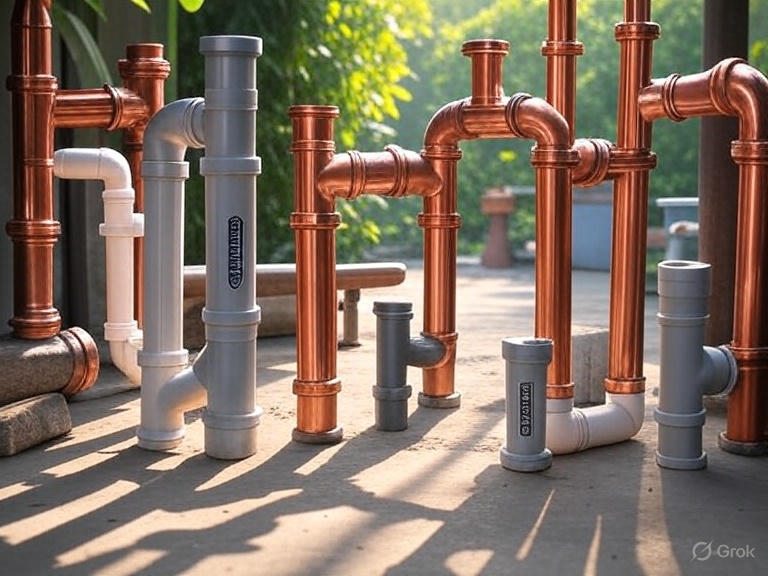
October 01, 2025 - Zed van der Vyver
Introduction to Plumbing in Thailand
Plumbing is the backbone of any home or building in Thailand, handling water supply, drainage, and waste removal in a country where monsoons, high humidity, and urban growth create unique challenges. It’s not just pipes and fixtures—it ensures safe, efficient water use. This blog will explain why plumbing matters in Thailand, the different types for various needs, how they’re made, and what they might cost. No technical background needed—just straightforward info to help you understand this essential system!
Why Plumbing Is Essential in Thailand
Plumbing delivers clean water for drinking, cooking, and bathing while removing wastewater to prevent contamination. In Thailand, it’s crucial due to the tropical climate: heavy rains can overwhelm drainage, leading to floods in Bangkok or Chiang Mai, while hard water in some areas causes scale buildup. It also supports hygiene in humid conditions where mold thrives. From rural homes relying on rainwater systems to urban condos with high-pressure needs, plumbing prevents health risks and ensures comfort year-round.
Types of Plumbing for Different Scenarios in Thailand
Plumbing systems vary by use and location, and the right type depends on your setup and climate. Here’s a look at common types in Thailand and where they fit best:
PVC Plumbing Systems
Use: Residential drainage or low-pressure lines.
Why: Lightweight, corrosion-resistant plastic pipes handle Thailand’s wet climate well. Affordable and easy to install.
Example Scenario: A home in Nonthaburi.
Copper Plumbing Systems
Use: Hot water lines or premium homes.
Why: Durable and heat-conductive, they resist scaling from hard water in coastal areas like Phuket.
Example Scenario: A villa in Krabi.
PEX Plumbing Systems
Use: Flexible water supply in modern builds.
Why: Flexible plastic tubing bends easily, ideal for tight urban spaces. It’s resistant to freezing, though rare in Thailand.
Example Scenario: A condo in Bangkok.
Stormwater Drainage Systems
Use: Flood-prone or rural areas.
Why: Larger pipes and channels direct heavy monsoon runoff, often with grates to catch debris.
Example Scenario: A house in Ayutthaya.
Your choice depends on water pressure, climate, and building type. Thai brands like SCG or local plumbers offer solutions tailored to the region.
How Plumbing Is Made in Thailand
Plumbing components in Thailand are manufactured to withstand humidity and monsoons while meeting local standards. Here’s a general overview of the process:
- Material Selection: PVC is made from vinyl chloride resin, copper from mined ore, and PEX from cross-linked polyethylene. Local factories use recycled materials where possible.
- Extrusion or Molding: PVC and PEX are heated and extruded into pipes through dies. Copper is drawn into tubes from ingots. Fittings are injection-molded.
- Assembly: Pipes are cut to length, with joints glued (PVC), soldered (copper), or crimped (PEX). Valves and fixtures are added.
- Testing: Systems are pressure-tested for leaks, essential for Thailand’s variable water quality.
- Finishing: Pipes are marked with standards (e.g., TIS certification) and packaged for distribution.
Factories in Chonburi or Bangkok produce PVC and PEX, while copper is often imported and fabricated locally.
Cost Comparison of Plumbing in Thailand
Plumbing costs in Thailand vary by type, length, and installation. Here’s a breakdown (in Thai Baht per meter for pipes, as of October 2025):
| Plumbing Type | Cost (THB per meter) | Typical Use | Notes |
|---|---|---|---|
| PVC Systems | 50–150 | Drainage | Cheapest; fittings add 20–50 THB each. |
| Copper Systems | 200–500 | Hot water | Premium; labor-intensive installation. |
| PEX Systems | 100–300 | Water supply | Flexible; quick install reduces labor. |
| Stormwater Drainage | 150–400 | Flood areas | Larger pipes; includes grates (500–1,000 THB). |
Example Calculation: 20 meters of PVC for drainage might cost 1,000–3,000 THB, while copper for the same length could be 4,000–10,000 THB. Full installation adds 5,000–20,000 THB per home, higher in cities like Pattaya. Prices are up 10–15% since 2020 due to material costs.
Final Thoughts
Plumbing in Thailand ensures safe water flow and waste removal, adapted to the tropical climate’s demands. Whether PVC for a budget home or copper for a luxury villa, there’s a type for every need. Consider your water source, climate challenges, and budget, and hire a local plumber for compliance. Good plumbing is the unseen hero of a comfortable home. Got questions? Leave a comment—we’re here to help!
